- RT @ScottATaylor: Get a Daily Summary of Your Friends’ Twitter Activity [FREE INVITES] http://bit.ly/4v9o7b #
- Woo! Class is over and the girls are making me cookies. Life is good. #
- RT @susantiner: RT @LenPenzo Tip of the Day: Never, under any circumstances, take a sleeping pill and a laxative on the same night. #
- RT @ScottATaylor: Some of the United States’ most surprising statistics http://ff.im/-cPzMD #
- RT @glassyeyes: 39DollarGlasses extends/EXPANDS disc. to $20/pair for the REST OF THE YEAR! http://is.gd/5lvmLThis is big news! Please RT! #
- @LenPenzo @SusanTiner I couldn’t help it. That kicked over the giggle box. in reply to LenPenzo #
- RT @copyblogger: You’ll never get there, because “there” keeps moving. Appreciate where you’re at, right now. #
- Why am I expected to answer the phone, strictly because it’s ringing? #
- RT: @WellHeeledBlog: Carnival of Personal Finance #235: Cinderella Edition http://bit.ly/7p4GNe #
- 10 Things to do on a Cheap Vacation. https://liverealnow.net/aOEW #
- RT this for chance to win $250 @WiseBread http://bit.ly/4t0sDu #
- [Read more…] about Twitter Weekly Updates for 2009-12-19
My Financial Life
My financial life right now is boooring.
And that’s a good thing.
When I started this site I was $90,000 in debt, and considering bankruptcy. I’d just started on the Dave Ramsey plan and was looking for every possible way to scrape up any extra money I could.
Now, the debt is nearly gone.

- I’m looking at the last $8000 on my mortgage. I have enough in savings to pay it off today, without draining my savings completely dry.
- My IRA gets maxed out every year, and this year, my wife’s will be, too.
- We save or invest about 30% of our income.
- My credit score according to CreditKarma.com is 826.
Our credit card is almost paid off every month. There’s occasionally some overlap between our auto-payment and our charges. And sometimes the budgeted auto-payment doesn’t match the reality of our spending and I don’t notice for a week or two. Except for the end of last year, but that’s a post for another day.
The short version is: We’re doing well, and we’re nearing the end of our financial problems.
Our scheduled mortgage over-payments will have it completely paid off in October. Then we are debt-free and can hopefully manage to live the rest of our lives without paying interest on money that isn’t earning us more than we are paying. For example, I’m willing to take out a mortgage to buy another rental property, but I’m going to wait to do that until our current mortgage is paid and we have a substantial down payment ready.
No debt.
I’m not kidding when I say it’s been a long 6 years of fighting our debt. Counting a car loan we got and paid early, we’ve paid more than $110,000 of debt in six years.
I’ve run side businesses, aggressively negotiated raises, and left companies(voluntarily and otherwise) for better pay & benefits.
I’ve watched friends and family take vacations around the world.
I’ve turned my kids down for so many things that I would love to buy them, but couldn’t because being financially secure is a much higher priority than spoiling children. Try explaining that to a 6 year old.
And now, the debt-ridden part of our financial journey is almost over. Finally.
So what’s next?
I have no idea. I’d like to travel more. Linda and the girls want us to move to a hobby farm and get horses. We want more rental properties.
Whatever “next” is, it will be done from a position of strength that won’t destroy our financial world or put out futures at risk.
My Financial Plan – How I Improve on Ramsey
In April, my wife and I decided that debt was done. We have hopefully closed that chapter in our lives. I borrowed, then purchased, The Total Money Makeover by Dave Ramsey.  budget” width=”300″ height=”213″ />We are almost following his baby steps. Our credit has always been spectacular, but we used it a lot. Our financial plan is Dave Ramsey’s The Total Money Makeover, with some adjustments.
budget” width=”300″ height=”213″ />We are almost following his baby steps. Our credit has always been spectacular, but we used it a lot. Our financial plan is Dave Ramsey’s The Total Money Makeover, with some adjustments.
Step 1. Budget:
The budget was painful, and for the first couple of months, impossible. We had no idea what bills were coming due. There were quarterly payments for the garbage bill and annual payments for the auto club. It was all a surprise. Surprises are setbacks in a budget.
When something came up, we’d start budgeting for it, but stuff kept coming up. We’re not on top of all of it, yet, but we are so much closer. We’ve got a virtual envelope system for groceries, auto maintenance, baby needs(we have two in diapers) and some discretionary money. We set aside money for everything that isn’t a monthly expense, and have a line item for everything that is. My wife is eligible for overtime and monthly bonuses. That money does not get budgeted. It’s all extra and goes straight on to debt, or to play catch-up with the bills we had previously missed. I figure it will take a full year to get all of the non-monthly expenses in the budget and caught up.
Step 2. The initial emergency fund:
Ramsey recommends $1000, adjusted for your situation. I decided $1000 wasn’t enough. That isn’t even a month’s worth of expenses. We settled on $1800, plus $25/month. It’s still not enough, but it’s better. Hopefully, we’ll be able to ignore it long enough that the $25/month accrues to something worthwhile.
Step 3. The Debt Snowball:
This is the controversial bad math. Pay off the lowest balance accounts first, then take those payments and apply them to the higher balance accounts. Emotionally, it’s been wonderful. We paid off the first credit card in a couple of weeks, followed 6 weeks later by my student loan. Since April, we’ve dropped nearly $10,000 and we haven’t made huge cuts to our standard of living. At least monthly, we re-examine our expenses to see what else can be cut.
Step 4. Three to six months of expenses in savings:
We aren’t on this step yet. In step 2, we are consistently depositing more, making us more secure every month.
Step 5. Invest 15% of household income into Roth IRAs and pre-tax retirement:
I have not stopped my auto-deposited contribution. It’s stupid to pass up an employer match. My wife’s company does not match, so she is currently not contributing.
Step 6. College funding for children:
We have started a $10 College fund.
Step 7. Pay off home early:
I don’t see the point in handling this one separately. Our mortgage is debt, and when the other debts are paid, we will be less than a year from owning our house, free and clear. This is rolled in with step three. All debt is going away, immediately.
Step 8. Build wealth and give!
We have cut off most of our charitable giving. Every other year, it has been a significant percent of our income, and in a few more years, will be so again. The only exception to this is children knocking on the door for fundraisers. I have no problems with saying no to a parent fundraising for their kid, but when the kids is doing the work, door-to-door, especially in the winter, I buy something. My son’s school, on the other hand, gets fundraisers ignored. When they come home, I send a check to the school, ignoring the program. I bypass the overhead and make a direct donation.
What Is Your Binary Options Strategy?
 When you are just entering the world of binary options trading or investing, you may be on the receiving end of a lot of advice. It is not uncommon to hear people tell you to implement different gambling strategies because binary options are based on chance more than anything else. You will also hear a lot of advice from those who say there are many good ways to develop an effective strategy using indicators and market signals. Some will insist that with proper analysis of market data, a solid strategy can be developed too.
When you are just entering the world of binary options trading or investing, you may be on the receiving end of a lot of advice. It is not uncommon to hear people tell you to implement different gambling strategies because binary options are based on chance more than anything else. You will also hear a lot of advice from those who say there are many good ways to develop an effective strategy using indicators and market signals. Some will insist that with proper analysis of market data, a solid strategy can be developed too.
Are they all correct? Interestingly enough, the answer is yes. The reason for this is simple, and as one expert writes, “there is no such thing as a perfect strategy for every trader. There is only a best strategy for each individual trader.” Thus, your strategy has to be shaped around a few things:
- Your willingness and ability to follow your chosen strategy.
- Your personality. For instance, are you restless if you are taking the safe route or a higher risk strategy?
- Your budget and goals,
Identifying the answers to these questions is the first step to formulating a strategy. You should also understand that the winning percentage of most strategies will be somewhat constant, but the total number of successful trades varies on an individual basis and is based entirely on the strategies used.
For instance, some investors want a high percentage of winning trades and are more comfortable with risk averse trading. Others are ready to take more risk and are entirely comfortable winning fewer trades if the returns on winning trades are dramatically higher. This enables them to implement higher risk trades. The interesting thing about strategies and the kinds of trades they generate is that they are all built from the same data.
The Data of Strategy
For example, almost all strategies will look at issues like market trends, trading trends, highs and lows, reversals, and various kinds of indicators. The reason that high and low trends pay off in strategy development is simple: binary options trading applies to whether or not an asset rises above a strike price or doesn’t. It is the proverbial “yes or no” part of the proposition and analysis for either outcome pays off.
As an example, a lot of risk-averse investors will look for breakouts. They use these for trend line investing, which can be as brief as sixty seconds to a day, but can be used to coordinate investing in the direction of a short trend. Although this seems complex, it really is not. The key is that analysis cannot be broad and across all available markets. Instead, focused analysis on a specific area will allow even a novice investor to analyze for a breakout and then invest in binary options accordingly.
Just being able to detect a reversal or a downward trend over the course of a day can yield a very rewarding investment. The key is to understand your strategy based on your budget, personality, and your ability to stick with the strategy, even if it does not yield immediate success. When you do this, and use the right tools for analysis, you can create an effective strategy that brings you closer to your goals.
This is a guest post.
Book Review: The Art of Non-Conformity

We grew up in a world of expectations: Eat your vegetables, don’t poop on the carpet, do your homework. It continues right up to “Go to college”, “Get married”, “Having a dozen kids”. Are those the expectations you want to use to guide your life?
Chris Guillebeau, author of The Art of Non-Conformity (the blog and the book) puts the question like this: We we were younger, we heard “If everyone else was jumping off of a cliff, would you do that too?” In theory, that meant we were supposed to think for ourselves. Yet, as adults, we are absolutely expected to conform and do the things everyone else is doing. Work your 40, take a week’s vacation once a year, and repeat until retirement or death.
Is that our only choice?
The Art of Non-Conformity attempts to be a guidebook, showing you how to live the live you want to live. Chris has made a lifelong series of decidedly unconventional choices, from dropping out of high school to attending 3 colleges simultaneously to spending 4 years as a volunteer in Africa. For the past few years, he has been working his way through visiting every country in the world. He is an expert on non-conformity.
The books tells a lot (a LOT) of stories of people who have either made the leap into a self-defined life or people who have done nothing but talk about taking that leap while staying comfortable in their soul-numbing careers.
The Good
The Art of Non-Conformity is an inspirational book. It spends a lot of time explaining how to break through the wall of fear to take control of your like. More important, it explains why you’d want to. It does not pretend to define how you should live your life, it just provides the framework for the mentality to help you make that decision for yourself.
The Bad
If you’re looking for a step-by-step guide, complete with a list of possible work-alternatives, this isn’t the book for you. This book approaches lifestyle design from the conceptual end rather than the practical. If you want a practical manual, I’d get the 4 Hour Workweek by Timothy Ferris. Ideally, you should get both. They complement each other well.
Overall, I thoroughly enjoyed the book. If you’re considering taking a non-standard path or just hate the career- or life-track you are on, you should read The Art of Non-Conformity. I’m planning to read it again in a couple of weeks, just to make sure I absorb all of the lessons.
Protection for your Loved Ones

This is a guest post.
Life cover insurance acts as a safety net to pay for a family’s expenses should a wage earner become critically ill or die prematurely. Life cover includes life insurance as well as disability, critical illness, mortgage and income protection insurance policies.
Importance of life cover insurance
In most families, at least one adult is a wage earner and uses their income to pay for necessities such as food, clothing and rent or mortgage. If the wage earner becomes disabled, too ill to work, or dies, life cover insurance can pay for these expenses.
Stay-at-home parents provide valuable, though unpaid, services to the family. Without that person, the family would have to pay for childcare, household upkeep, errand running, and every other chore the stay-at-home parent did. If the stay-at-home parent has life insurance, these expenses can be covered.
Life cover insurance can pay off mortgages and education loans.
Live cover insurance policies will pay funeral costs, which can be substantial.
Family owned businesses can be insured and protected if the owner dies.
Objections
Life cover insurance is too expensive.
Insurance companies have plans to suit every budget and life circumstance. While young and healthy adults will generally receive the most affordable policies, older adults have plenty of reasonably priced options as well.
Disability or severe illness is unlikely.
Actually, 32% of men and 25% of women, ages 40 to 70, will experience a critical illness or disability. http://www.healthinsuranceguide.co.uk/statistics_mainbody.asp
Discussing disability or death is awkward and uncomfortable.
Agreed, but avoiding the topic puts loved ones into economic jeopardy. Without the wage earner’s life cover, a family could lose their home and have to lower their standard of living.
Variety of life cover insurances
Life Insurance
Term insurance is a protection policy, paid for during a specific time period (term), and is active during that time only. Permanent, whole, variable, universal and universal variable life insurance policies all are investment policies. They combine a death benefit (the amount paid out when the insured person dies) with an investment account. Licensed and experienced life insurance agents can help individuals make the best choice for their life situation.
Critical Illness/Disability Insurance
This type of insurance pays for living expenses if a person is diagnosed with a serious illness or disabled and can no longer work.
Mortgage Insurance
This is paid when the mortgage owner dies. This could help prevent the surviving family from having to sell the home.
The time to buy life cover insurance is now!
A 2010 survey (http://www.prnewswire.com/news-releases/ownership-of-individual-life-insurance-falls-to-50-year-low-limra-reports-101789323.html) stated that individual life insurance ownership was at a 50 year low in the United States. An estimated 35 million (30% of households) Americans do not have life insurance, and 11 million of these households have children under 18. Already living paycheck to paycheck, any debilitating injury or death of a wage earning adult could spell financial disaster to the family. Buying life cover insurance is a vital part of caring for loved ones. Just as a wage earner provides a home, food and daily necessities for their family, life cover insurance can take over and provide for the family if the wage earner unable to do so.


